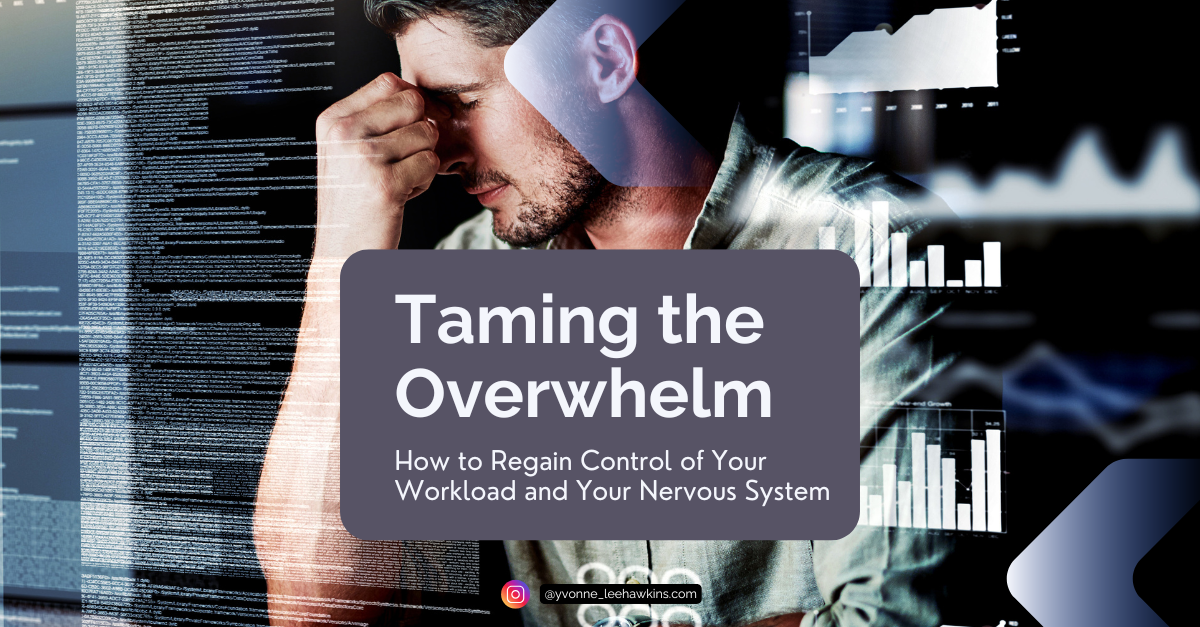How to Regain Control of Your Workload and Your Nervous System
This week’s topic is reader submitted. Thank you to the Wellness Wednesday Community! Keep showing up and asking the important questions.
Have you ever opened your laptop, looked at your inbox or calendar, and felt dread? The emails pile up faster than you can read them, you go from one meeting to the next, and suddenly, everything seems urgent, and even deciding what task to tackle first feels impossible.
If you’ve felt this way, you’re not alone. Overwhelm isn’t a sign of weakness. It’s your brain and body sounding the alarm: “Warning! System Overload!”
But here’s the good news: overwhelm is a momentary response, not your modus operandi (way of operating). You can shift it. Today, we’ll explore practical strategies to calm your nervous system, clear the mental fog, and reclaim control of your workday.
Let’s start with why it’s more important now than ever.
New Reality: More with less
Today’s workplace environment has changed. Companies are asking employees to do more with less. They’re flattening organizations, trimming resources, and pushing more work onto fewer people. It’s easy to get swept up trying to do everything and be everything.
But here’s a hard truth: You can’t take everything on.
One of the most important skills you can build in business today isn’t about saying “yes” — it’s about having the courage and wisdom to say “no.”
Saying no to low-priority tasks, to unnecessary meetings, to distractions is not selfish. It’s strategic. It’s how you protect your energy for what truly matters. It’s how you survive — and thrive — in a world asking more of you than ever before.
Let me tell you a story about a brilliant project manager named “Jamie” (not her real name). Jamie was smart, capable, and driven — but she often ended her days drained, feeling like she had worked all day and accomplished nothing.
One coaching session, I asked her to share her screen. What I saw shocked us both: 47 open browser tabs, 6 unfinished emails, and a blinking Slack channel begging for attention. Jamie laughed and said, “Welcome to my brain.”
Her screen wasn’t just chaotic. It was a perfect mirror of how her nervous system felt: scattered, frayed, exhausted. You probably know a Jamie or might even be one.
We started small. First, we closed all but three tabs. Then, we picked one “needle-moving” task and made it her priority. We also built in small “reset” moments throughout her day to regulate her nervous system. Within two weeks, Jamie reported feeling calmer, more focused, and — surprisingly — actually getting more done.
If you aren’t in corporate work, your overwhelm might look different, but overwhelm isn’t about where you work or what you do.
It’s about your nervous system trying to manage more demand than your current capacity can comfortably handle.
Your overwhelm might look like this:
- As a stay-at-home parent, it’s the relentless swirl of snack requests, spilled milk, and emotional outbursts before you’ve even had your morning coffee.
- As a medical worker, it’s the constant beeping of monitors, critical decisions, and back-to-back patients without a real break to breathe, let alone decompress.
- As a small business owner, it’s the never-ending to-do list, the pressure to keep clients happy, the marketing, the accounting, the late-night worrying — all stacked on your shoulders.
Different jobs. Different lives.
But the same story: too much, too fast, for too long.
Here are practical ways you can start to reclaim your whelm (wink), I mean life, one step at a time.
Step 1: Calm Your Nervous System First
You can’t think clearly when your body is in fight-or-flight mode. The very first step to beating overwhelm isn’t time management — it’s nervous system management.
Try this 60-second reset right now:
- Box Breathing (also used by Navy SEALs to stay calm under pressure)
- Inhale for 4 counts
- Hold for 4 counts
- Exhale for 4 counts
- Hold for 4 counts
- Repeat for 4 rounds
It sounds simple, but it signals safety to your body. It tells your brain, “You’re okay. You can think clearly.” Even better if you put your hand on your heart and say to yourself (silently or out loud), “I am safe.” Sounds silly but it works.
Step 2: Conduct a “Brain Dump”
Grab a piece of paper (yes, paper — not another open tab!) and write down everything swirling in your mind. Work tasks, personal errands, worries, ideas — dump it all.
This gives your brain permission to stop trying to juggle it all internally. Writing it on paper and creating a physical thing helps your brain get it OUT. While writing lists in a word doc or google sheet can help, paper still works best.
Step 3: Pick Your “Vital Few”
From that brain dump, choose 3 key tasks that, if completed today, would make you feel accomplished.
Ask yourself:
- What will move the needle? (Is there a task that replaces or makes other tasks irrelevant? For example, asking a partner or assistant to help schedule something takes all the tasks related to that event off your plate).
- What is urgent and important? (if it seems urgent right now but wouldn’t matter 5 days or 5 weeks from now, it can wait).
- What would reduce my stress tomorrow if I finished it today? (perhaps something you’ve been avoiding for a while, just do it and move on).
Important: You may have 30 things “to do” but focusing on 3 things gives you momentum and protects your mental energy.
Step 4: Time-Box Your Focus
Now, set a timer for 25 minutes (this is the Pomodoro Technique) and work on one task with no distractions. No checking email. No “just a quick scroll” on Instagram.
One task. 25 minutes.
Then take a 5-minute break where you physically move — stretch, walk, shake out your arms.
Step 5: Build “Mini-Resets” Into Your Day
Your brain wasn’t designed to sprint for 8 hours straight. Plan tiny recovery moments throughout your workday:
- 60 seconds of deep breathing
- Standing up and stretching for 2 minutes
- Looking out a window (distance gazing calms the brain)
- Drinking a glass of water slowly
- Spend 5-10 minutes outside near a tree or green space
Think of these as hitting “Save” on your nervous system.
Momentum Beats Perfection
Here’s the biggest mindset shift that helped Jamie — and can help you:
Overwhelm whispers, “You have to do it all perfectly.” But I love this line from Jen Sincero, author of “You are a Badass,” where she says “done is better than perfect.” The truth is: Action creates clarity. Momentum beats perfection.
Start imperfectly. Start small. But start.
You don’t climb a mountain by staring at the peak. You climb it one step at a time.
You Are Not Your To-Do List
You are not “behind.” You are not “failing.” You are a capable human navigating a noisy world.
Every time you take a deep breath, choose your “vital few,” protect your boundaries, and honor your own rhythm, you are reclaiming your power.
Today, tame the tabs. Tame the to-dos. Tame the overwhelm.
Your nervous system (and your future self) will thank you.
When and How to talk to your manager about an unmanageable workload
If you find your workload has become unmanageable, or you don’t have the autonomy to make these decisions, it’s important to bring it to your manager’s attention proactively and professionally. Start by documenting specific examples of your current responsibilities and the challenges you’re facing. When you meet, frame the conversation around finding solutions rather than simply venting. You might say something like, “I want to make sure I’m prioritizing the most important work for the team. Right now, I’m at capacity with these projects [list them], and I’m concerned about maintaining quality. Can we review priorities together or discuss possible support options?” Approaching the conversation with clarity, collaboration, and a focus on outcomes shows initiative and invites your manager to be a partner in solving the problem.
The discussion looks different if you are an individual contributor, a manager, a leader, or if you work directly for the owner. I created a quick guide for these discussions HERE. Free of charge, just ways to walk into those discussions prepared.
Take Action Today:
- Try 1 round of box breathing
- Brain dump your tasks
- Choose your “Vital 3”
- Time-box your next task for 25 minutes
- Practice saying no to one non-essential request
- Talk to your manager using this guide
Small steps create big shifts.
You’ve got this!
***
Did this topic add value to you? Please like and subscribe if you want more topics like this, or DM me. I always love suggestions and feedback!
And if you are too burned out and overwhelmed to even begin to use any of these strategies it might be time to get some help. Find a coach, therapist, or doctor who can help you reverse out of the physical, mental, and emotional symptoms of burnout so you can get back to living in life you love.
Remember, Self-care isn’t selfish…it’s required!
Yvonne Lee-Hawkins, IPHM, is a holistic Leadership and Wellness coach, stress strategist, and writer, who spent 20 years in corporate and leadership functions. When she is not working, she loves to go on nature adventures with her family, in the Pacific Northwest where they call home. You can find out more on her website, or follow her on Instagram, LinkedIn, or Medium.
If you want some help beating overwhelm, or with general wellness, schedule a call here.
Lastly, sharing is caring. If you know someone who would benefit from this article, please forward it to them!

